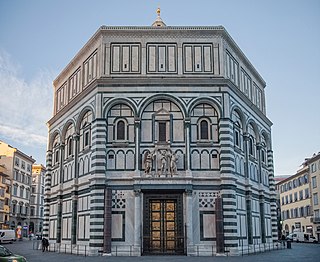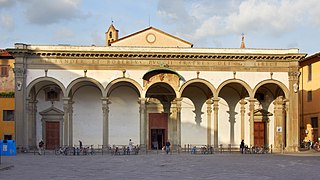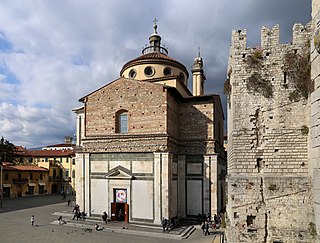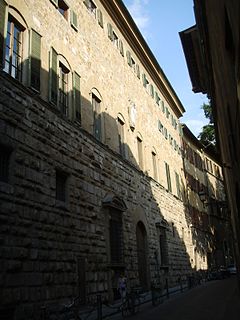
Leon Battista Alberti was an Italian Renaissance humanist author, artist, architect, poet, priest, linguist, philosopher, and cryptographer; he epitomised the nature of those identified now as polymaths. He is considered the founder of Western cryptography, a claim he shares with Johannes Trithemius.

Renaissance architecture is the European architecture of the period between the early 15th and early 16th centuries in different regions, demonstrating a conscious revival and development of certain elements of ancient Greek and Roman thought and material culture. Stylistically, Renaissance architecture followed Gothic architecture and was succeeded by Baroque architecture. Developed first in Florence, with Filippo Brunelleschi as one of its innovators, the Renaissance style quickly spread to other Italian cities. The style was carried to Spain, France, Germany, England, Russia and other parts of Europe at different dates and with varying degrees of impact.

Santa Maria Novella is a church in Florence, Italy, situated opposite, and lending its name to, the city's main railway station. Chronologically, it is the first great basilica in Florence, and is the city's principal Dominican church.

The Florence Baptistery, also known as the Baptistery of Saint John, is a religious building in Florence, Italy, and has the status of a minor basilica. The octagonal baptistery stands in both the Piazza del Duomo and the Piazza San Giovanni, across from Florence Cathedral and the Campanile di Giotto.

The Basilica della Santissima Annunziata is a Renaissance-style, Catholic minor basilica in Florence, region of Tuscany, Italy. This is considered the mother church of the Servite Order. It is located at the northeastern side of the Piazza Santissima Annunziata near the city center.

Prato is a city and comune in Tuscany, Italy, the capital of the Province of Prato. The city lies in the north east of Tuscany, at the foot of Monte Retaia, elevation 768 metres (2,520 ft), the last peak in the Calvana chain. With more than 200,000 inhabitants, Prato is Tuscany's second largest city and the third largest in Central Italy.

Palazzo Strozzi is a palace in Florence, Italy.

Palazzo Spini Ferroni is a large Gothic palace located along Via de' Tornabuoni at the corner of Piazza Santa Trinita, in central Florence, region of Tuscany, Italy. It stands across from the church of Santa Trinita.

Palazzo Davanzati is a palace in Florence, Italy. It houses the Museum of the Old Florentine House.
The decade of the 15th century in art involved some significant events.

San Zeno is a church and a former abbey in Pisa, Tuscany, Italy.

Santa Maria delle Carceri is a basilica church, designed by Giuliano da Sangallo, and built in Prato, Tuscany, Italy. It is among the earliest examples of a Greek cross plan for a complete church in Renaissance architecture.

San Pancrazio is a church in Florence, Italy, in Piazza San Pancrazio, behind Palazzo Rucellai. With the exception of the Rucellai Chapel, it is deconsecrated and is home to the museum dedicated to the sculptor Marino Marini. The Rucellai Chapel contains the Rucellai Sepulchre or Tempietto del Santo Sepolcro. Since February 2013 it has been possible to visit the chapel from within the Marini museum.

Piazza Santa Croce is one of the main plazas or squares located in the central neighbourhood of Florence, in the region of Tuscany, Italy. It is located near Piazza della Signoria and the National Central Library, and takes its name from the Basilica of Santa Croce that overlooks the square.

De pictura is a treatise or commentarii written by the Italian humanist and artist Leon Battista Alberti. The first version, composed in Latin in 1435, was not published until 1450. It is one of his three treatises on art; the other two are De statua and De re aedificatoria, that would form the Renaissance concept for the fine arts: painting, sculpture, and architecture.

Palazzo Capponi alle Rovinate is a late-Gothic and early Renaissance-style residential palace located on Via de' Bardi in Florence, region of Tuscany, Italy. There are apparently three other palaces once associated with the Capponi family:

The Torre dei Gianfigliazzi is a Romanesque-style medieval tower-residence located on Via de' Tornabuoni #1 in central Florence, region of Tuscany, Italy. It can be seen rising adjacent to the left of the church of Santa Trinita. It now hosts a hotel.

Palazzo Malenchini Alberti is a palace in Florence, Italy. It was owned by the Alberti, who had also a tower nearby.

The Museo Horne is a museum focusing on art and furnishings of the 14th and 15th centuries, located in the former Palazzo Corsi, on via de' Benci number 6 in Florence, Tuscany, Italy.

Villa Pandolfini is a Renaissance villa near Florence, Italy in Lastra a Signa, and close to the Arno River.





















